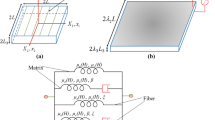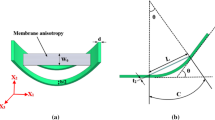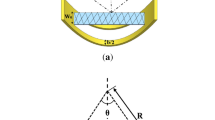Abstract
Soft materials exhibiting large deformation under external stimuli have gained an increasing attention in the recent past because of their potential applications in soft transducers aimed at achieving biomimetic actuation. This paper theoretically analyzes the effect of internal properties, including entanglements, crosslinks and finite extensibility of polymer chains along with inherent viscoelastic properties of polymers on the performance of Dielectric Elastomer actuator (DEA) in dynamic modes of actuation. A physics based nonaffine material model proposed by Davidson and Goulbourne is used to model the polymer chains entanglements, crosslinks and finite extensibility. To incorprate the viscoelastic properties, a rheological material model based on the additive decomposition of the isotropic strain energy density into equilibrium and viscous parts is implemented. A computationally efficient method, which relies on the principle of least action is used for extracting the governing equation representing the dynamic motion of the DE actuator. The results demonstrate that DEAs with strong entanglements and crosslinks along with small finite extensibility of polymer chains exhibits lower deformation level in DC dynamic modes of actuation. It is inferred that the strong entanglements and crosslinks in polymer chains enhances the resonant frequency, but debilitate the intensity of vibration of viscoelastic DEAs. Further, the periodicity and stability of the nonlinear oscillations exhibited by the viscoelastic DEAs are assessed by employing the Poincare maps and phase portraits. The results of the present investigation can be applied effectively in bridging the mechanism between the microcosmic polymer chains and macroscopic dynamic behavior of viscoelastic DE actuators.

















Similar content being viewed by others
References
Bai, Y., Jiang, Y., Chen, B., Foo, C.C., Zhou, Y., Xiang, F., Zhou, J., Wang, H., Suo, Z.: Cyclic performance of viscoelastic dielectric elastomers with solid hydrogel electrodes. Appl. Phys. Lett. 104(6), 062902 (2014)
Bar-Cohen, Y.: Electroactive polymers as artificial muscles-reality and challenges. (2001)
Bortot, E.: Nonlinear dynamic response of soft thick-walled electro-active tubes. Smart Mater. Struct. 27(10), 105025 (2018)
Bozlar, M., Punckt, C., Korkut, S., Zhu, J., Foo, C.C., Suo, Z., Aksay, I.A.: Dielectric elastomer actuators with elastomeric electrodes. Appl. Phys. Lett. 101(9), 091907 (2012)
Carpi, F., Bauer, S., De Rossi, D.: Stretching dielectric elastomer performance. Science 330(6012), 1759–1761 (2010)
Carpi, F., Frediani, G., Turco, S., De Rossi, D.: Bioinspired tunable lens with muscle-like electroactive elastomers. Adv. Funct. Mater. 21(21), 4152–4158 (2011)
Foo, C.C., Cai, S., Koh, S.J.A., Bauer, S., Suo, Z.: Model of dissipative dielectric elastomers. J. Appl. Phys. 111(3), 034102 (2012)
Foo, C.C., Koh, S.J.A., Keplinger, C., Kaltseis, R., Bauer, S., Suo, Z.: Performance of dissipative dielectric elastomer generators. J. Appl. Phys. 111(9), 094107 (2012)
Dai, H., Wang, L.: Nonlinear oscillations of a dielectric elastomer membrane subjected to in-plane stretching. Nonlinear Dyn. 82(4), 1709–1719 (2015)
Dai, H., Zou, J., Wang, L.: Effect of initial stretch ratio on the electromechanical responses of dielectric elastomer actuators. Appl. Phys. A 122(5), 1–6 (2016)
Davidson, J.D., Goulbourne, N.C.: A nonaffine network model for elastomers undergoing finite deformations. J. Mech. Phys. Solids 61(8), 1784–1797 (2013)
Eder-Goy, D., Zhao, Y., Bai-Xiang, X.: Dynamic pull-in instability of a prestretched viscous dielectric elastomer under electric loading. Acta Mech. 228(12), 4293–4307 (2017)
Fox, J.W., Goulbourne, N.C.: On the dynamic electromechanical loading of dielectric elastomer membranes. J. Mech. Phys. Solids 56(8), 2669–2686 (2008)
Godara, R.K., Joglekar, M.M.: Mitigation of residual oscillations in electrostatically actuated microbeams using a command-shaping approach. J. Micromech. Microeng. 25(11), 115028 (2015)
Godara, R.K., Sharma, A.K., Joshi, N., Joglekar, M.M.: A novel capacitive mass sensor using an open-loop controlled microcantilever. Microsyst. Technol. 26, 2977–2987 (2020)
Guo-Ying, G., Gupta, U., Zhu, J., Zhu, L.-M., Zhu, X.: Modeling of viscoelastic electromechanical behavior in a soft dielectric elastomer actuator. IEEE Trans. Robot. 33(5), 1263–1271 (2017)
Joglekar, M.M.: Dynamic-instability parameters of dielectric elastomer actuators with equal biaxial prestress. AIAA J. 53(10), 3129–3133 (2015)
Joglekar, M.M., Pawaskar, D.N.: Estimation of oscillation period/switching time for electrostatically actuated microbeam type switches. Int. J. Mech. Sci. 53(2), 116–125 (2011)
Kashyap, K., Sharma, A.K., Joglekar, M.M.: Nonlinear dynamic analysis of aniso-visco-hyperelastic dielectric elastomer actuators. Smart Mater. Struct. 29, 055014 (2020)
Keplinger, C., Kaltenbrunner, M., Arnold, N., Bauer, S.: Capacitive extensometry for transient strain analysis of dielectric elastomer actuators. Appl. Phys. Lett. 92(19), 192903 (2008)
Keplinger, C., Li, T., Baumgartner, R., Suo, Z., Bauer, S.: Harnessing snap-through instability in soft dielectrics to achieve giant voltage-triggered deformation. Soft Matter 8(2), 285–288 (2012)
Keplinger, C., Sun, J.-Y., Foo, C.C., Rothemund, P., Whitesides, G.M., Suo, Z.: Stretchable, transparent, ionic conductors. Science 341(6149), 984–987 (2013)
Khan, K.A., Wafai, H., El-Sayed, T.: A variational constitutive framework for the nonlinear viscoelastic response of a dielectric elastomer. Comput. Mech. 52(2), 345–360 (2013)
Khurana, A., Kumar, A., Raut, S.K., Sharma, A.K., Joglekar, M.M.: Effect of viscoelasticity on the nonlinear dynamic behavior of dielectric elastomer minimum energy structures. Int. J. Solids Struct. 208, 141–153 (2021)
Kiser, J., Manning, M., Adler, D., Breuer, K.: A reduced order model for dielectric elastomer actuators over a range of frequencies and prestrains. Appl. Phys. Lett. 109(13), 133506 (2016)
Lee, H.S., Phung, H., Lee, D.-H., Kim, U.K., Nguyen, C.T., Moon, H., Koo, J.C., Choi, H.R., et al.: Design analysis and fabrication of arrayed tactile display based on dielectric elastomer actuator. Sens. Actuators A Phys. 205, 191–198 (2014)
Li, B., Zhang, J., Chen, H., Li, D.: Voltage-induced pinnacle response in the dynamics of dielectric elastomers. Phys. Rev. E 93(5), 052506 (2016)
Li, Y., Inkyu, O., Chen, J., Zhang, H., Yuhang, H.: Nonlinear dynamic analysis and active control of visco-hyperelastic dielectric elastomer membrane. Int. J. Solids Struct. 152, 28–38 (2018)
Liu, Y., Liu, L., Zhang, Z., Jiao, Y., Sun, S., Leng, J.: Analysis and manufacture of an energy harvester based on a Mooney-Rivlin-type dielectric elastomer. EPL 90(3), 36004 (2010)
Lu, T., Huang, J., Jordi, C., Kovacs, G., Huang, R., Clarke, D.R., Suo, Z.: Dielectric elastomer actuators under equal-biaxial forces, uniaxial forces, and uniaxial constraint of stiff fibers. Soft Matter 8(22), 6167–6173 (2012)
Moretti, G., Rosset, S., Vertechy, R., Anderson, I., Fontana, M.: A review of dielectric elastomer generator systems. Adv. Intell. Syst. 2(10), 2000125 (2020)
Nayfeh, A.H., Mook, D.T.: Nonlinear Oscillations. Wiley, London (2008)
Patra, K., Kumar, R.S.: A visco-hyperelastic approach to modelling rate-dependent large deformation of a dielectric acrylic elastomer. Int. J. Mech. Mater. Des. 11(1), 79–90 (2015)
Pelrine, R., Kornbluh, R., Pei, Q., Joseph, J.: High-speed electrically actuated elastomers with strain greater than 100%. Science 287(5454), 836–839 (2000)
Pharr, M., Sun, J.-Y., Suo, Z.: Rupture of a highly stretchable acrylic dielectric elastomer. J. Appl. Phys. 111(10), 104114 (2012)
Plante, J.-S., Dubowsky, S.: Large-scale failure modes of dielectric elastomer actuators. Int. J. Solids Struct. 43(25), 7727–7751 (2006)
Rosset, S., Araromi, O.A., Shintake, J., Shea, H.R.: Model and design of dielectric elastomer minimum energy structures. Smart Mater. Struct. 23(8), 085021 (2014)
Sarban, R., Lassen, B., Willatzen, M.: Dynamic electromechanical modeling of dielectric elastomer actuators with metallic electrodes. IEEE/ASME Trans. Mechatron. 17(5), 960–967 (2011)
Sharma, A.K.: Design of a command-shaping scheme for mitigating residual vibrations in dielectric elastomer actuators. J. Appl. Mech. 87(2), 021007 (2020)
Sharma, A.K., Joglekar, M.M.: A computationally efficient locking free numerical framework for modeling visco-hyperelastic dielectric elastomers. Comput. Methods Appl. Mech. Eng. 352, 625–653 (2019)
Sharma, A.K., Joglekar, M.M.: A numerical framework for modeling anisotropic dielectric elastomers. Comput. Methods Appl. Mech. Eng. 344, 402–420 (2019)
Sharma, A.K., Joglekar, M.M.: Effect of anisotropy on the dynamic electromechanical instability of a dielectric elastomer actuator. Smart Mater. Struct. 28(1), 015006 (2018)
Sharma, A.K., Bajpayee, S., Joglekar, D.M., Joglekar, M.M.: Dynamic instability of dielectric elastomer actuators subjected to unequal biaxial prestress. Smart Mater. Struct. 26(11), 115019 (2017)
Sharma, A.K., Arora, N., Joglekar, M.M.: Dc dynamic pull-in instability of a dielectric elastomer balloon: an energy-based approach. Proc. R. Soc. A Math. Phys. Eng. Sci. 474(2211), 20170900 (2018)
Sharma, A.K., Godara, R.K., Joglekar, M.M.: Static and dc dynamic pull-in analysis of curled microcantilevers with a compliant support. Microsyst. Technol. 25(3), 965–975 (2019)
Sharma, A.K., Kumar, P., Singh, A., Joglekar, D.M., Joglekar, M.M.: Electromechanical instability of dielectric elastomer actuators with active and inactive electric regions. J. Appl. Mech. 86(6), 061008 (2019)
Sharma, A.K., Sheshkar, N., Gupta, A.: Static and dynamic stability of dielectric elastomer fiber composites. Mater Today Proc (2021). https://doi.org/10.1016/j.matpr.2020.12.151
Sheng, J., Chen, H., Li, B.: Effect of temperature on the stability of dielectric elastomers. J. Phys. D Appl. Phys. 44(36), 365406 (2011)
Sheng, J., Chen, H., Li, B., Wang, Y.: Nonlinear dynamic characteristics of a dielectric elastomer membrane undergoing in-plane deformation. Smart Mater. Struct. 23(4), 045010 (2014)
Suo, Z.: Mechanics of stretchable electronics and soft machines. MRS Bull. 37(03), 218–225 (2012)
Thomson, G., Yurchenko, D., Val, D.V.: Dielectric elastomers for energy harvesting. In: Manyala R (ed) Energy harvesting. IntechOpen (2018). https://doi.org/10.5772/intechopen.74136
Vatanjou, H., Hojjat, Y., Karafi, M.: Nonlinear dynamic analysis of dielectric elastomer minimum energy structures. Appl. Phys. A 125(9), 583 (2019)
Wissler, M., Mazza, E.: Modeling and simulation of dielectric elastomer actuators. Smart Mater. Struct. 14(6), 1396 (2005)
Bai-Xiang, X., Mueller, R., Theis, A., Klassen, M., Gross, D.: Dynamic analysis of dielectric elastomer actuators. Appl. Phys. Lett. 100(11), 112903 (2012)
Yong, H., He, X., Zhou, Y.: Electromechanical instability in anisotropic dielectric elastomers. Int. J. Eng. Sci. 50(1), 144–150 (2012)
Zhang, J., Chen, H., Sheng, J., Liu, L., Wang, Y., Jia, S.: Dynamic performance of dissipative dielectric elastomers under alternating mechanical load. Appl. Phys. A 116(1), 59–67 (2014)
Zhang, J., Chen, H., Li, B., McCoul, D., Pei, Q.: Coupled nonlinear oscillation and stability evolution of viscoelastic dielectric elastomers. Soft Matter 11(38), 7483–7493 (2015)
Zhang, J., Tang, L., Li, B., Wang, Y., Chen, H.: Modeling of the dynamic characteristic of viscoelastic dielectric elastomer actuators subject to different conditions of mechanical load. J. Appl. Phys. 117(8), 084902 (2015)
Zhang, J., Chen, H., Li, D.: Nonlinear dynamical model of a soft viscoelastic dielectric elastomer. Phys. Rev. Appl. 8(6), 064016 (2017)
Zhang, J., Jie, R., Chen, H., Li, D., Jian, L.: Viscoelastic creep and relaxation of dielectric elastomers characterized by a Kelvin-Voigt-Maxwell model. Appl. Phys. Lett. 110(4), 044104 (2017)
Zhang, J., Chen, H., Li, D.: Modeling nonlinear dynamic properties of dielectric elastomers with various crosslinks, entanglements, and finite deformations. J. Appl. Phys. 123(8), 084901 (2018)
Zhao, X., Suo, Z.: Method to analyze electromechanical stability of dielectric elastomers. Appl. Phys. Lett. 91(6), 061921 (2007)
Zhu, J., Luo, J.: Effect of entanglements on the electromechanical stability of dielectric elastomers. EPL 119(2), 26003 (2017)
Zhu, J., Luo, J.: Effects of entanglements and finite extensibility of polymer chains on the mechanical behavior of hydrogels. Acta Mech. 229(4), 1703–1719 (2018)
Zhu, J., Luo, J., Xiao, Z.: Snap-through instability analysis of dielectric elastomers with consideration of chain entanglements. Mater. Res. Express 5(6), 065307 (2018)
Zhu, J., Cai, S., Suo, Z.: Nonlinear oscillation of a dielectric elastomer balloon. Polym. Int. 59(3), 378–383 (2010)
Zhu, J., Cai, S., Suo, Z.: Resonant behavior of a membrane of a dielectric elastomer. Int. J. Solids Struct. 47(24), 3254–3262 (2010)
Acknowledgements
The authors gratefully acknowledge the anonymous reviewers for their insightful comments. This research is supported financially by the Science and Engineering Research Board (SERB), India through Grant No. EMR/2017/003289 and the Department of Science and Technology(DST), Government of India through Grant No. DST/INSPIRE/04/2019/000500.
Author information
Authors and Affiliations
Corresponding author
Ethics declarations
Conflict of interest
The author(s) declared no potential conflicts of interest with respect to the research, authorship, and/or publication of this article.
Additional information
Publisher's Note
Springer Nature remains neutral with regard to jurisdictional claims in published maps and institutional affiliations.
Appendix: Governing equations of DE membrane subjected to equal biaxial prestress
Appendix: Governing equations of DE membrane subjected to equal biaxial prestress
In order to validate the efficacy of the developed framework with the experimental observations reported by [30], it is assumed that the DE membrane is also subjected to initial equal biaxial prestress S. The work done due to applied equal biaxial prestress S is expressed [43] as
Hence, the total potential energy U (Eq. 9) of the considered DE actuator subjected to electromechanical loading become
Since the relaxation due to applied prestress is assumed to be completed before voltage excitation starts, one can determine the equilibrium stretch \(\lambda _p\), induced by the prestress. At equilibrium state, the viscous strain is equal to the total strain, i.e., \(\displaystyle \left. {\lambda _v } \right| _{t = 0} = \left. \lambda \right| _{t = 0}\) [12]. For this particular stated state, the associated elastic energy in the hyperelastic element of the Maxwell element is released, i.e.,work done associated with viscous part \(W_v\) = 0. Upon invoking this condition and on setting the first variation of the total potential energy U with respect to stretch \(\lambda \) equal to zero, i.e., \(\displaystyle \frac{{\mathrm{d}U}}{{\mathrm{d}\lambda }} = 0\), the equilibrium equation is expressed as
The value of prestress S required to obtained the prestretch \(\lambda _p\) in the DE membrane can be evaluated by implementing \(\lambda = \lambda _p\) and \(\phi = 0\) in Eq. (A.3) for any given value of material parameters as
The resulting nonlinear governing differential equation of motion Eq. (13) of the DE actuator including the expressions of initial equal biaxial pre stress is expressed as
The evolution Eq. (15) of the considered DE membrane is written as
Hence, modified three initial conditions of the DE membrane due to initially applied pre stress (Eq. 16) are expressed as
In order to fit the experimental data, Lu et al. [30] implemented the Gent model with the following material parameters of the DE membrane (VHB4905), shear modulus \(\mu = 45\) kPa, permittivity \(\varepsilon = 3.98\times 10^{ - 11}\) F m\(^{ - 1} \), thicknes \(H = 0.5\) mm and limiting stretch material constant \(J_{\lim } = 120\) respectively.
To validate the present model, we also use the same group of material parameters. we have \(\mu = \mu _e + \mu _c = 45\) kPa, permittivity \(\varepsilon = 3.98\times 10^{ - 11} Fm^{ - 1} \), thicknes \(2H = 0.5\) mm, \(\displaystyle \lambda _{\max } = \sqrt{\frac{{J_{\lim } + 3}}{3}} = 6.4\) and modulus ratio \(\displaystyle \frac{{\mu _e }}{{\mu _c }} = 0.18\). This modulus ratio can be tuned to get the best fitted curves with the experimental results. The other important required material parameters considered are the density of the DE membrane (VHB4905) \(\rho = 960\) kg m\(^{ - 3}\) [33] and viscoelastic relaxation time, which ranges from a few seconds to hundreds of seconds at room temperature, \(\displaystyle \tau _v = \frac{\eta }{{\mu _c \beta }}=10^2\) s [7, 20].
Finally for the stated parameters, the nonlinear differential Eq. (A.5) together with evolution Eq. (A.6) and initial conditions (Eq. A.7) are solved using MATLAB for evaluating the lateral stretch \(\lambda \) at applied voltage \(\phi \). The voltage \(\phi \) was applied using a programmable voltage source with a ramping rate of \(0.5kVs^{ - 1} \).
Rights and permissions
About this article
Cite this article
Khurana, A., Kumar, A., Sharma, A.K. et al. Effect of polymer chains entanglements, crosslinks and finite extensibility on the nonlinear dynamic oscillations of dielectric viscoelastomer actuators. Nonlinear Dyn 104, 1227–1251 (2021). https://doi.org/10.1007/s11071-021-06328-z
Received:
Accepted:
Published:
Issue Date:
DOI: https://doi.org/10.1007/s11071-021-06328-z




